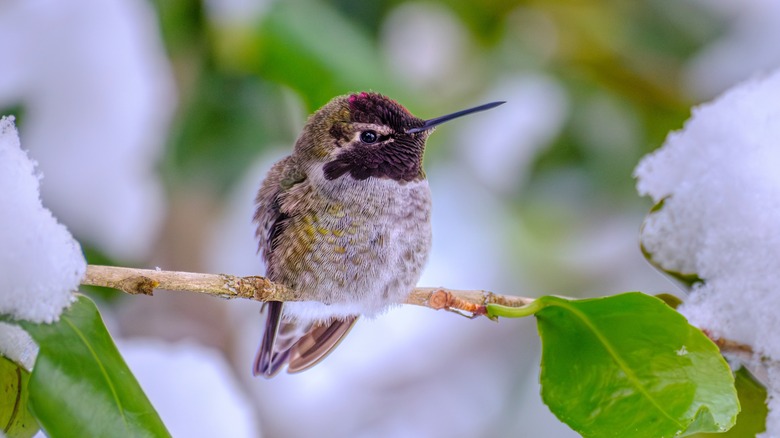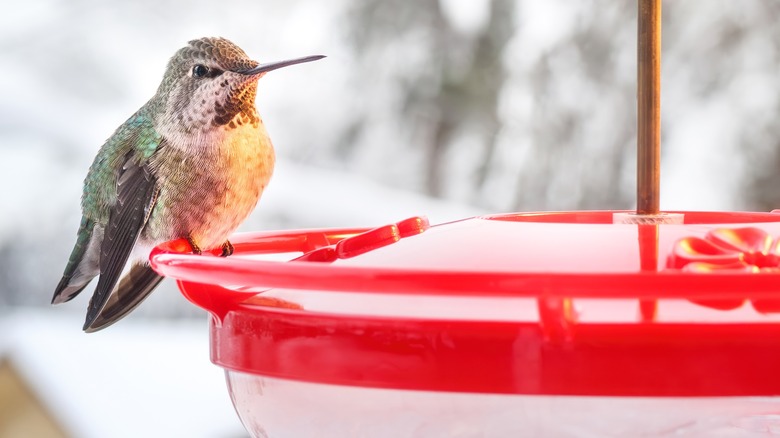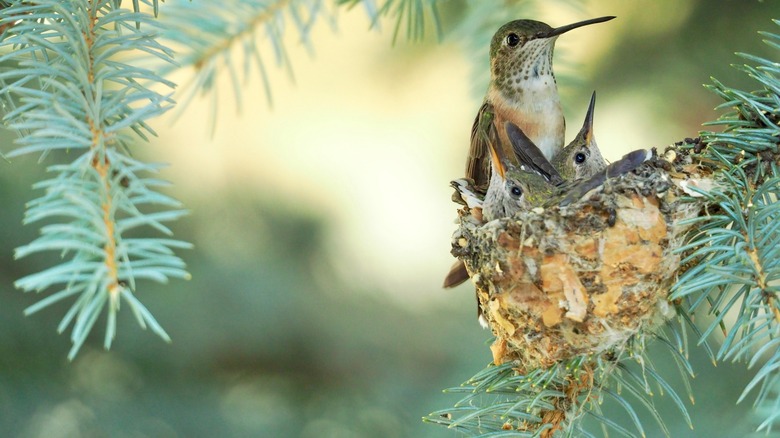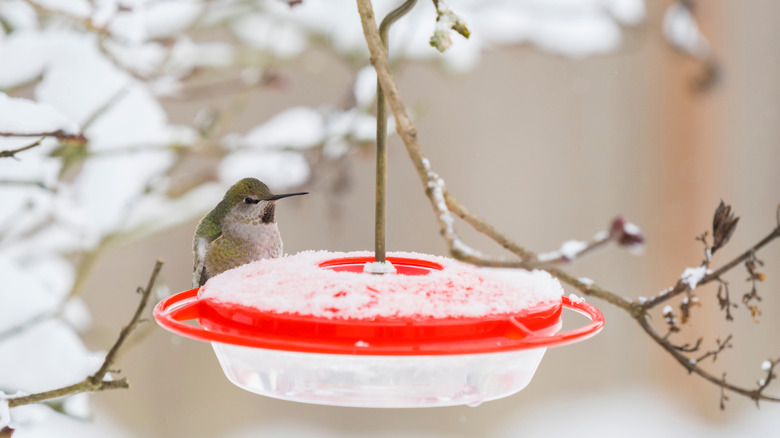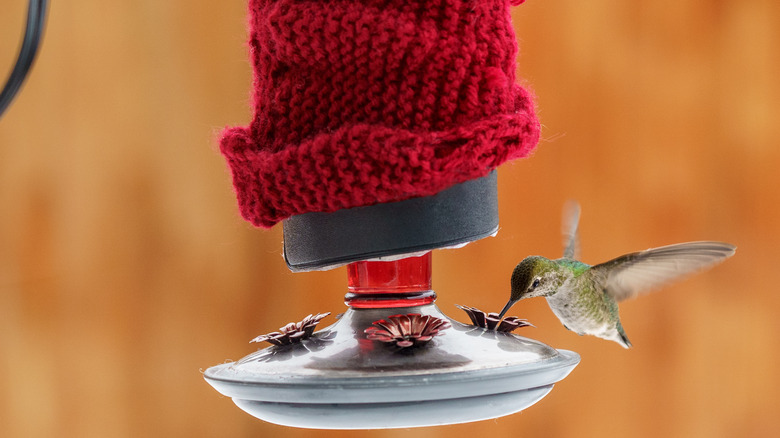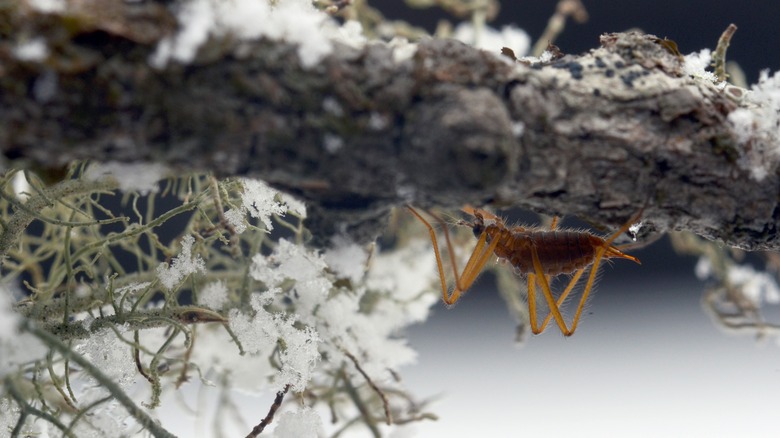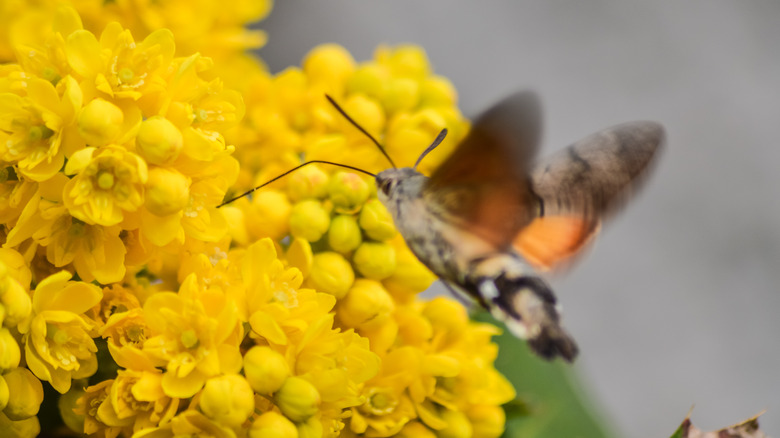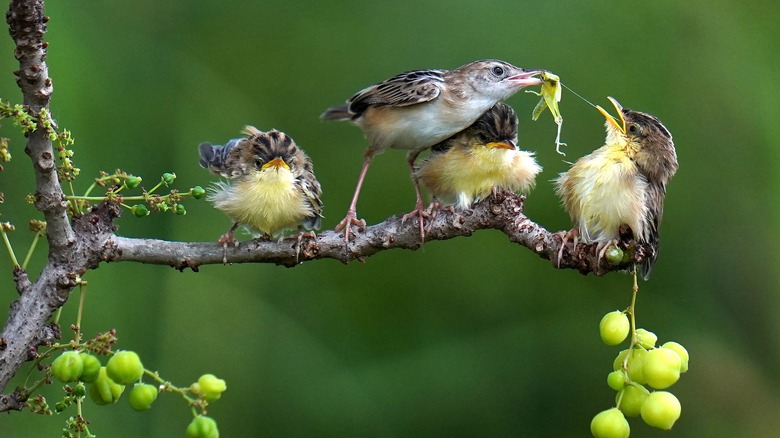Tips And Tricks For Attracting Hummingbirds To Your Yard During Winter
Though most species of hummingbirds will migrate to warmer climates during the coldest months of the year, several species of hummers spend winter in North America. Rufous hummingbirds are commonly spotted through winter in the southeastern and eastern states, while Anna's hummingbirds, ruby-throated hummingbirds, and buff-bellied hummingbirds are among the varieties you can expect to see in the warmer coastal regions of the U.S. as temperatures drop. These feathered fliers are renowned for their insatiable appetites, needing to feed every 10 to 15 minutes to sustain their energy levels. If you want to attract these beautiful birds to your yard through the coldest season, you should focus on providing them with sources of food.
A hummingbird's diet consists of nectar, insects, and spiders, but all of these food sources are more scarce in winter, because there are fewer flowers in bloom and many insects will hibernate or migrate to warmer climates. To make your yard a haven for hummingbirds, you can use various tips and tricks to have them flocking throughout the colder months. One of the best things you can do to attract hummingbirds in winter is to install a feeder in your garden and keep it topped up with a sugar water mixture. When natural food sources are in short supply for hummingbirds, they can survive on a sugar solution for up to 10 days. Consider growing flowering plants that will bloom in winter, or add shrubs and trees to your yard that provide nesting opportunities to hummingbirds.
Fill hummingbird feeders or shallow dishes with warm sugar water
A simple sugar water recipe can be introduced in the garden at any time of year to attract hummingbirds, but it's especially beneficial in the winter when other sources of food for these creatures are more difficult to come by. A feeder or shallow dish filled with sugar water will have flocks of hummingbirds visiting your yard, but be warned that it's a practice you'll have to commit to once you start. Feathered friends can come to rely on sugar water feeders through the colder months, and if they are suddenly found empty this can be fatal.
Create a recipe of sugar water using one part refined white sugar, and four parts water. Mix the ingredients until the sugar has dissolved. Warming the mixture gently on the stove can help the sugar to dissolve more quickly, and kill any bacteria that may have been present in faucet water. Serve the sugar water to hummingbirds in feeders when it is still warm — this will help them keep their body temperature up and enable them to conserve more energy. Ingredients you should never feed the hummingbirds visiting your yard include honey, molasses, brown sugar, or sugar alternatives, as these can cause health problems for the birds. Don't make the mistake of putting your hummingbird feeder in the wrong spot, like near a window. Instead, opt for a sheltered or quiet position in your yard where the birds can enjoy their sugar water in peace.
Create cover for nesting hummingbirds with shrubs and trees
Providing a space that will appeal to nesting hummingbirds is a brilliant way to attract these creatures and get them coming back year after year, as the little winged wonders are known for returning to their old nest areas. Some hummingbird species, like Anna's hummingbirds, start nesting in November. They like to nest in private and well-sheltered spots in shrubs and trees, so evergreen plants that won't lose their leaves in winter make a good choice and provide what the hummingbirds need during those cold months. Typically, hummingbird nests will be built on branches that are between 5 and 20 feet from ground level, so bear this in mind when selecting species to grow in your garden.
The best types of trees and shrubs to grow in your yard that will supply nesting spots for hummingbirds through winter will depend on your climate. In cooler regions, consider the Japanese maple tree (Acer palmatum) which is suitable for USDA hardiness zones 5 to 8. At a typical height of 20 feet, these trees sit at the right level for nesting hummingbirds. Conifers represent a good option for most regions, and they are popular amongst ruby-throated hummingbirds, who are known to nest in coniferous woods and forests. Large shrubs can also be a great place for nesting hummingbirds to create a home, so try to grow a range of different plants that will provide sheltering opportunities for these delightful creatures. One evergreen shrub that'll attract hummingbirds throughout winter is the fragrant sarcococca (Sarcococca confusa). It will contribute shelter and nesting spots through the colder months, and it even blooms during winter for an additional source of food.
Use brightly colored feeders to attract the attention of hummingbirds
Ever wondered why hummingbirds are always spotted on brightly colored flowers? It's because they have a poor sense of smell, which means they rely on visual cues to find their food. Bold and vibrant colors, such as red and pink, are known to attract hummingbirds, so you can use these hues to gain their attention. Brightly colored feeders are a good idea for attracting hummingbirds all year round, but they are especially important in winter when natural food sources are in lower supply. Hummingbirds can develop a reliance on feeders to provide them with the sustenance they need to survive through the colder months, so ensuring you have a feeder that is obviously visible to a hummingbird could save its life.
Most hummingbird feeders on the market are red, pink, or orange, so it should be easy to find a feeder in a suitable color that will help draw these birds to your yard. This plastic Zelpont Hummingbird Feeder is a good choice, because it is made from red plastic and also features faux flowers to help attract the birds. If you don't want to purchase a new feeder, there are some easy DIYs you can use to make your existing feeder more attractive to hummingbirds. Consider tying a red ribbon around the top of the feeder, or paint the openings with bright pink nail polish. Don't use red dye or food coloring inside your feeder to attract the birds, as it's not good for these feathered friends.
Prevent feeders from freezing so birds can access food during winter
Hummingbirds can come to rely on sugar water feeders to sustain themselves through winter, because the natural food sources they find in the wild, such as flowers and insects, are more scarce through the colder months. Hummingbirds are creatures of habit, so when they identify a food source, such as a feeder, they will return to it. The best time of year to put out your hummingbird feeder is in the winter, but only if you can ensure the food inside it doesn't freeze. If a feeder freezes in cold weather and the hummingbird can't access the sugar water, it may starve. This is why it's crucial to take steps to prevent garden feeders from freezing through winter. Tactics to stop feeders from freezing include insulating them with a sock or knitted cover and using heaters.
One of the best ways to keep your hummingbird feeder from freezing as temperatures drop is to bring feeders indoors at the end of each day and return them outside first thing the following morning. Alternatively, use two feeders and rotate them each day to allow one to thaw. You can also purchase hummingbird feeder heaters that are specifically designed to prevent the sugar water from freezing. This Shworon Hummingbird Feeder Heater attaches to the bottom of an existing feeder and uses a 7-watt bulb to generate heat. Some people recommend using more sugar in sugar water mixes through winter to prevent freezing, but this should actually be avoided because it may pose health risks to hummingbirds. Position feeders in an area sheltered from snow or wind to further protect them from freezing, and avoid using feeders with metal parts, as these can hurt the birds when they get very cold. It's essential to remember to clean feeders to minimize the spread of disease; bacterial or fungal growth on feeders can cause bird's tongues to swell and lead to fatal consequences.
Allow spaces for overwintering insects in the garden
Insects are the main source of food for hummingbirds. Though these birds might appear to spend most of their time feeding on nectar, this sugary goodness only represents a small fraction of their diet. Entomologist Doug Tallamy, chair of the Department of Entomology and Wildlife Ecology at the University of Delaware says (via the University of California) that "hummingbirds like and need nectar, but 80% of their diet is insects and spiders." Hummingbirds require the protein from insects to help them develop muscles and feathers. Through winter some insects hibernate, some migrate to warmer climates, and many seek shelter in piles of leaves or beneath logs. If you can create a safe haven for insects in your garden, you may in turn find that more hummingbirds visit your yard to get their fill of protein.
To turn your yard into a hummingbird feeding ground in winter, you should create areas where these tiny creatures can take shelter. In the fall, avoid pruning back shrubs and plants too heavily, and ease off from an intense fall cleanup. A slightly more unruly garden creates more habitats for insects to survive through winter, and more insects means more hummingbirds. However, it's important to balance this tip with a warning. Overgrown gardens not only create spaces for insects to shelter, but they also provide opportunities for unwanted visitors like snakes and rats to hide. If your neighborhood has a known pest issue, it would probably be best to keep your yard as neat and trimmed as possible, and instead turn to alternative tricks for attracting hummingbirds.
Grow nectar-rich plants that flower through winter
During summer, hummingbirds are spoilt for choice with a plethora of different flowers available, but come winter time, they can struggle to find natural sources of nectar. If you can grow plants in your yard that bloom during the winter, you'll create more opportunities for nearby hummingbird populations to visit our garden. Growing plants that flower through the colder months of the year will be beneficial for the birds. As an added bonus, you'll benefit from a bright and lively garden at a time when color is usually lacking.
Keep winter hummingbirds happy by planting a beautiful flowering species they'll love, such as a camellia or Oregon grape hybrid plant. Oregon grape hybrids (Mahonia x media) are an excellent source of winter nectar, producing long-lasting yellow blooms that will bring hummingbirds flocking. These shade-tolerant shrubs are easy to care for and will survive in most soil types. Salvia plants are another great choice for attracting hummingbirds in colder months. Rosemary (Salvia rosmarinus) can bloom throughout fall and winter, providing feeding opportunities for hungry hummingbirds. Mexican sage (Salvia leucantha) and pineapple sage (Salvia elegans) are also fall and winter flowering species that can attract hummingbirds.
Minimize pesticide use for a hummingbird-friendly yard
Since hummingbirds have fewer sources of food available in winter, it's important for home gardeners to take steps to maximize feeding opportunities for these birds. Insects make up the majority of a hummingbird's diet, with a single bird eating anywhere from a few hundred to a thousand insects in just one day. A key way to ensure there are enough insects in the yard to satisfy a hummingbird's voracious appetite is to think twice before using commercial insecticides and pesticides. These common garden treatments are known to destroy insect populations, which can be devastating for hummingbirds who need insects to survive. Pesticides can also be harmful to the birds themselves if they ingest chemicals that have been applied to flowers when they feed on the nectar.
Washington State University has identified that synthetic, broad-spectrum pesticides are the number one block to having a healthy insect population. Avoiding ongoing pesticide applications will allow beneficial insects to thrive in your garden throughout the year, but this is especially crucial through the winter months when food for hummingbirds is typically scarce. A garden rich in insects will be especially attractive to nesting hummingbirds, because their chicks are fed almost entirely on a diet of arthropods. If you do need to take steps to control a pest problem, using narrow-spectrum pesticides could limit harmful impacts to beneficial insect populations, and with that, hummingbirds.
